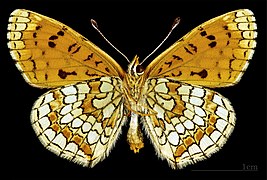Provençal fritillary
- View a machine-translated version of the French article.
- Machine translation, like DeepL or Google Translate, is a useful starting point for translations, but translators must revise errors as necessary and confirm that the translation is accurate, rather than simply copy-pasting machine-translated text into the English Wikipedia.
- Consider adding a topic to this template: there are already 1,433 articles in the main category, and specifying
|topic=will aid in categorization. - Do not translate text that appears unreliable or low-quality. If possible, verify the text with references provided in the foreign-language article.
- You must provide copyright attribution in the edit summary accompanying your translation by providing an interlanguage link to the source of your translation. A model attribution edit summary is
Content in this edit is translated from the existing French Wikipedia article at [[:fr:Mélitée des linaires]]; see its history for attribution. - You may also add the template
{{Translated|fr|Mélitée des linaires}}to the talk page. - For more guidance, see Wikipedia:Translation.
| Provençal fritillary | |
|---|---|
 | |
| Scientific classification | |
| Domain: | Eukaryota |
| Kingdom: | Animalia |
| Phylum: | Arthropoda |
| Class: | Insecta |
| Order: | Lepidoptera |
| Family: | Nymphalidae |
| Genus: | Melitaea |
| Species: | M. deione |
| Binomial name | |
| Melitaea deione Geyer, 1832 | |
| Synonyms | |
| |

The Provençal fritillary (Melitaea deione) is a butterfly in the family Nymphalidae.[1] It is found in south-western Europe and North Africa. The range extends from the Iberian Peninsula to southern France and the Alps in Switzerland and Italy. It is also found in the Atlas Mountains.
Description
In spite of its great similarity to athalia, this South-West European form is considered specifically distinct, particularly, it seems, because the wings are more elongate and there occur in South France and Spain also forms of athalia with which dejone is not identical. In markings more resembling athalia, in colour more parthenie. In the female the reddish yellow median band of the upperside is somewhat paler, so that there are two contrasting tints of reddish yellow. The underside nearly as in parthenie, the light bands of the hindwing as in parthenie not silvery and not divided by a black line. The individuals even from the same place differ so much that one might be inclined to place some with parthenie and others with athalia. Perhaps the insect will in future be proved to be a local or seasonal form of one of the allied species.[2]
-
 Male dorsal – MHNT
Male dorsal – MHNT -
 Male ventral - MHNT
Male ventral - MHNT -
 Female dorsal - MHNT
Female dorsal - MHNT -
 Female ventral - MHNT
Female ventral - MHNT
Biology
There are two generations per year with adults on wing from April to September. In the Alps, there is one generation.
The larva feeds on species of Linaria, Chaenorrhinum, Digitalis and Antirrhinum (including Antirrhinum sempervirens).
Subspecies
There are three subspecies:
- M. d. deione
- M. d. berisalii (Rühl, 1891)
- M. d. nitida (Oberthür, 1909) (west Morocco (Rif mountains), western Algeria (Tlemcen, Sebdou))
Etymology
In Greek mythology Deione, is the name given to Demeter's daughter, Persephone.
References
- ^ "Melitaea Fabricius, 1807" at Markku Savela's Lepidoptera and Some Other Life Forms
- ^ Seitz. A. in Seitz, A. ed. Band 1: Abt. 1, Die Großschmetterlinge des palaearktischen Faunengebietes, Die palaearktischen Tagfalter, 1909, 379 Seiten, mit 89 kolorierten Tafeln (3470 Figuren)
 This article incorporates text from this source, which is in the public domain.
This article incorporates text from this source, which is in the public domain.
External links

- Leps It












